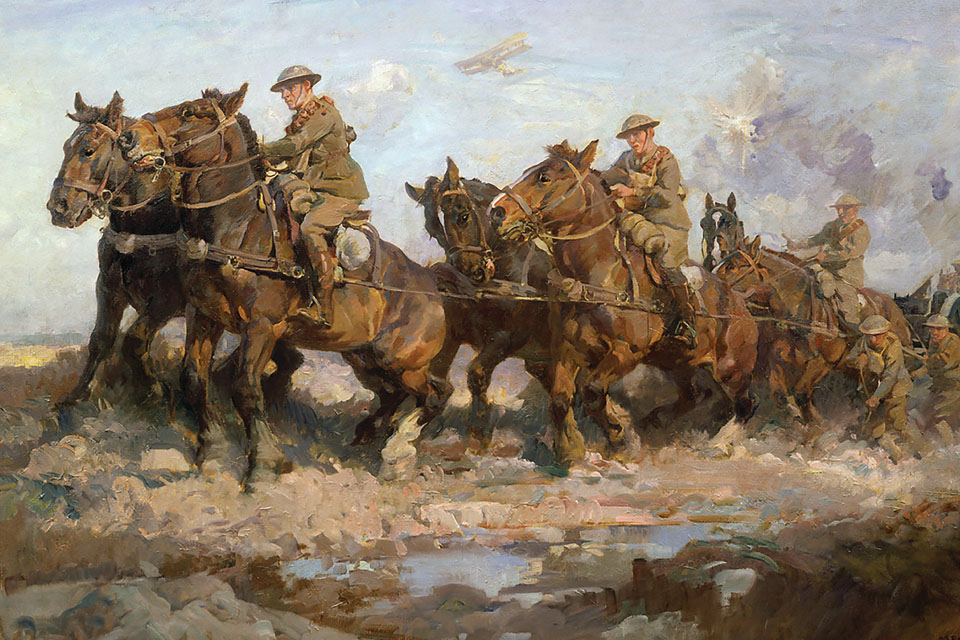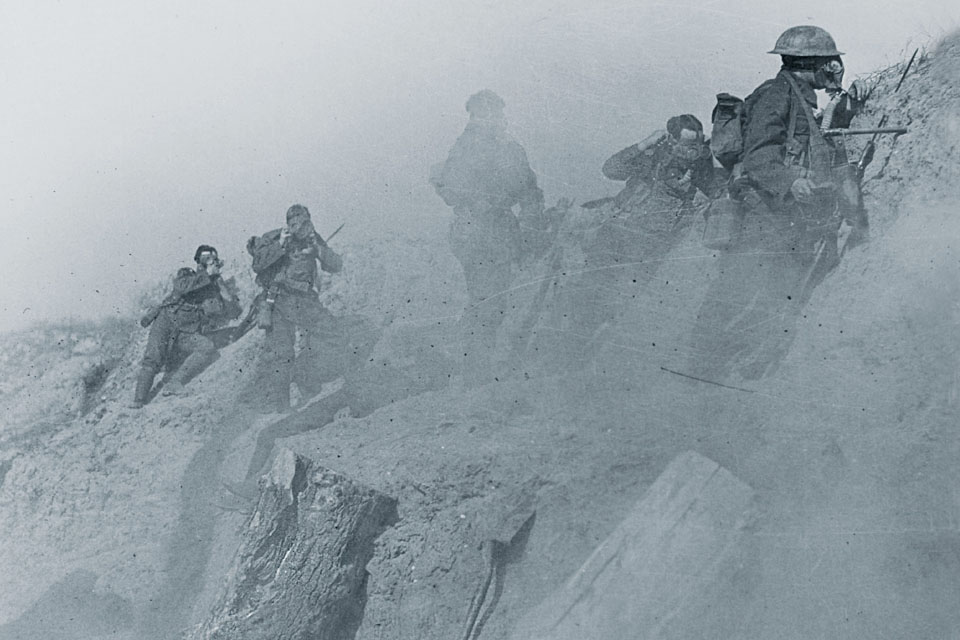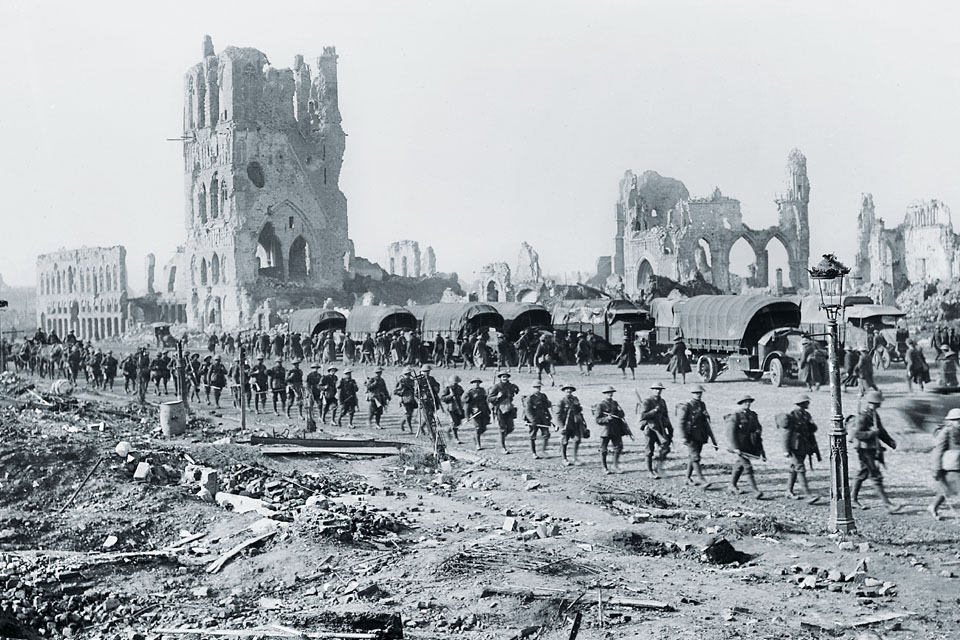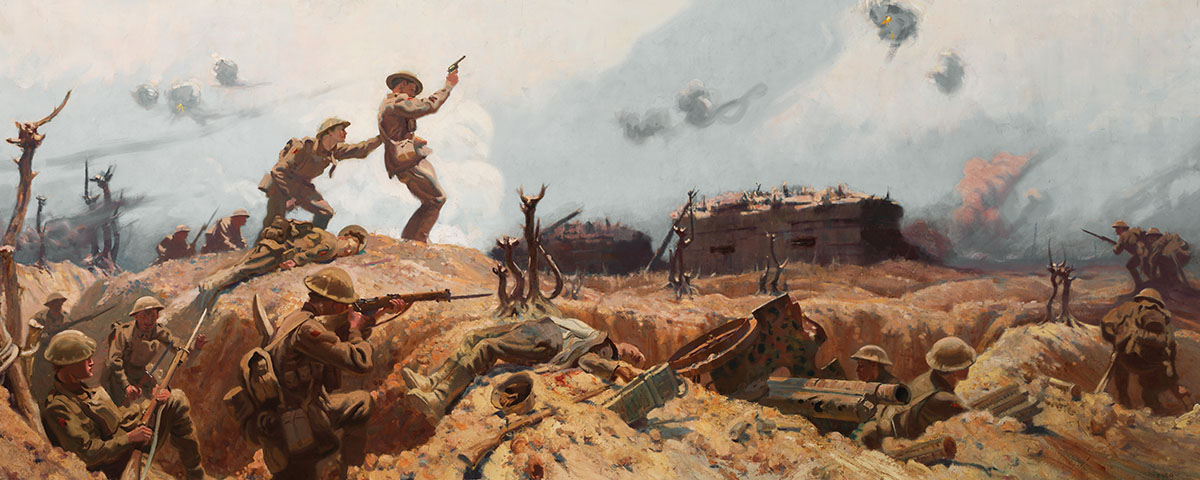The 1917 Battle of Passchendaele was a three-month slog through mud, blood, guts, rats and raining death.
The history of warfare is rife with accounts of battles that took a terrible human toll and others fought to no viable end. A student of military history would have to go to great lengths, however, to find a conflict that accomplished less at such a staggering cost in life than did the three-month 1917 engagement known officially as the Third Battle of Ypres but to history as Passchendaele, the name of the small Flemish village around which the battle raged.
During the war British soldiers phonetically translated Passchendaele as “Passion Dale”—a reference to Christ’s suffering on the cross. A later chronicler dubbed it the “Valley Where God Died.” Either sets the proper mood, for the battle has come to epitomize the suffering, futility and mindless slaughter that characterized World War I.
By the spring of 1917 the “war to end war,” as H.G. Wells termed it, was going badly for the Allies. Tens of thousands of French soldiers on the Western Front had mutinied or deserted in the wake of a failed offensive, the Russians’ attention was consumed by the communist revolution riving their nation, and the United States would not land troops in Europe until summer. In the interim Britain bore much of the military burden.
Further exacerbating the situation, Germany had resumed unrestricted submarine warfare. Sailing out of captured Belgian ports along the English Channel, its U-boats again systematically stalked and sank merchant vessels in international waters. The toll on Allied shipping proved devastating, and on June 19 Field Marshal Sir Douglas Haig, commander of the British Expeditionary Force, presented the War Cabinet in London a plan to eliminate the threat.

Haig’s plan centered on a long-contested salient—a bulge in the Allied front lines roughly the size of Manhattan—backed by the small town of Ypres, within 25 miles of the coast in the Flanders region of Belgium. British forces had recently won two victories within the salient, at Vimy in April and Messines in early June. In the mistaken belief the German army was on the brink of collapse, Haig reasoned signs were propitious for a major campaign. As he saw it, by launching a massive offensive against the Germans from Ypres, combined with an amphibious attack along the coast, he could drive his forces through the salient, liberate northern Belgium and seize the coastal cities that harbored the German submarines.
British Prime Minister David Lloyd George had serious misgivings about Haig’s plan. First and foremost, Allied troops had been bogged down in the trenches of the salient for years, unable to dislodge the enemy. The Allies maintained only a slim advantage over the Germans in manpower (perhaps 15 percent) and no advantage in firepower. The British could not count on full French support. Finally, even if Haig were able to reach the coast, there was no certainty of capturing the ports. All that was guaranteed was a massive loss of life.
Ultimately, however, advised by First Sea Lord Admiral of the Fleet Sir John Rushworth Jellicoe that Britain could not survive another year of unchecked U-boat warfare, Lloyd George reluctantly gave his approval.
Haig could hardly have chosen less hospitable ground for a major offensive. The opposing armies had hotly disputed the Ypres salient since 1914, and by the summer of 1917 it had been degraded beyond the realm of imagination. The battles in 1914 and 1915 had reduced the once quaint medieval market town of Ypres to rubble. On its outskirts shellfire had rendered apocalyptic what had once been lush fields of crops bounded by gentle, tree-lined slopes. In their place was a barren expanse of water-filled craters and blackened, wraithlike stumps.
From a tactical perspective, the Germans retained the high ground, and their artillery and machine gun nests commanded the no-man’s-land between the opposing trenches. The dominant elevation was the ridge on which stood the remnants of Passchendaele, largely pulverized to dust and broken bricks by the earlier fighting.
For nearly three years the armies had alternately advanced and withdrawn over the same ground, their gains and losses measured in yards. Interlaced fields of heavy fire made the salient a literal deathtrap, what author Winston Groom has termed a “giant corpse factory,” on which such innovative tools of war as tanks, flamethrowers and biplane bombers wreaked havoc on the landscape and men.
Yet Haig saw an opportunity to turn stalemate and attrition into victory.
The British general launched his offensive on July 31. The Allied force comprised more than a half-million men in 30 British and Commonwealth divisions, six Belgian divisions and, belatedly, six French divisions, all supported by 168 tanks and more than 3,000 artillery pieces. It was by any calculation an impressive assemblage. By then the planned amphibious assault along the Belgian coast had run into logistical obstacles and been postponed (it was ultimately cancelled), but Haig assured Lloyd George’s War Cabinet the delay would in no way jeopardize the success of his battle plan at Ypres.
Over the first 10 days the Allied big guns fired some four and a quarter million rounds, further churning the soil and destroying Flanders’ centuries-old drainage system, which had held back the waters of local creeks. Meanwhile, a long period of torrential rains—the heaviest in memory—struck the region, flooding the creeks and turning the fields to thick, deep mud. Over the weeks that followed, countless more artillery shells from both sides, as well as 60-pound bombs from German heavy bombers, churned the muddy ground into porridge.
The line of the salient remained virtually unaltered, as men, animals, tanks and guns wallowed in the mire. The all-but-impassable expanse over which Haig proposed to send hundreds of thousands of troops had become, in the words of Canadian historian Tim Cook, “a battlefield of despair, the place where soldiers went to die in the mud.”
Stymied by the impossible conditions that his own guns had in large measure created, Haig did not resume his attack until mid-August—again with practically no effect. In September he sent in reinforcements from the Australian and New Zealand Army Corps (ANZAC) to support the spent British forces. Nothing changed—the Allies advanced, seizing small portions of muddy ground, only to be forced back by German counteroffensives.
On October 4 the Allies managed to wrest control of one of the ridges east of Ypres, encouraging Haig to attempt yet another assault on Passchendaele Ridge. In the second week of October he launched two indecisive attacks, gaining little ground and losing another 20,000 men. Despite growing resistance from London, difficult terrain, poor weather and the increasingly debilitating conditions under which his exhausted army was living, Haig persisted.
Not all the deaths within the Ypres salient were the result of gunshot or shrapnel. Scores of wounded, careless and simply unlucky men—as well as countless army horses and mules—fell into water-filled shell holes and drowned.
Mud, however, was the soldiers’ deadliest obstacle. “The moment you set off, you felt that dreadful suction,” recalled Private Charles Miles of the 10th Battalion, Royal Fusiliers. “It was forever pulling you down.” It also clogged the muzzles and breeches of firearms, rendering them useless.

Men mired in the mud became stationary targets for German rifles, machine guns and artillery, dying in the slime and sinking anonymously into it. And horrible though the mud was for the advancing soldiers to negotiate, there were worse things underfoot. “When it yielded under your feet,” recalled Private Miles, “you knew that it was a body you were treading on. It was terrifying. You’d tread on one on the stomach, perhaps, and it would grunt all the air out of its body. It made your hair stand on end. The smell could make you vomit.”
During their constant artillery barrages, whenever winds allowed, the Germans mixed in rounds containing poison gas. The Germans first introduced chlorine gas at the Second Battle of Ypres in 1915. Even in small doses it induced coughing and vomiting. In concentration it could destroy lung tissues, causing death by asphyxiation.
By the time of Haig’s offensive the Germans had introduced the even more horrifying mustard gas. Although not always lethal, the sulfur-based agent could cause blindness, blistering burns and permanent damage to the respiratory and digestive systems. The threat of contamination persisted even after the gas cloud dissipated, as its residue saturated uniforms and settled on the ground and in the water, remaining toxic for days or weeks.
In the event of an attack, officers ordered their men to immediately don their gas masks. The clunky, ill-fitting masks formed a poor seal, and improved respirators were not available until late in the war. If the men lost or left behind their masks during an assault, they could counter the respiratory effects by urinating into a rag or handkerchief and covering their faces with the urea-soaked cloth. There was little protection for the rest of the body, as chemical suits had yet to be invented, and the penetrating gas could blister and peel off skin beneath one’s uniform.
Generally, the best way to determine the type of gas being used was by its smell. By this point in the campaign, however, competing odors were an ever-present problem. There were no latrines on the front lines; for safety reasons men were instructed to use crude waste pits carved from the mud of the trenches, then toss in lime to combat odor. An exercise in futility if there ever was one, as there were also no bathing facilities, and the unwashed soldiers, living day and night in perpetually wet wool uniforms, reeked.
Worst of all, the constant shelling frequently cast up from their nameless muddy graves the rotting corpses of men who had died days, weeks or months before. “There were bodies rotting everywhere,” one Western Front survivor recalled. “Nothing could be done about them. You could throw a shovel full of quick lime on them to take some of the smell away, but the odor of the trenches was appalling.” Rats flourished in such conditions.
Disease was also rampant. The unsanitary water supply made cholera a real and terrifying threat. In the ankle-deep mire trench foot was a common affliction. Left untreated, the affected appendage could become gangrenous and require amputation. Trench fever, transmitted by body lice, brought on a high temperature, muscular pain and a month-long recovery. Living conditions were so abysmal, soldiers were almost relieved when ordered “over the top.”
By mid-October Haig had pursued his offensive for nearly three months, with little to show for it other than a casualty list approaching 250,000—half his original troop strength. Despite the desperate efforts of the British troops, followed by those of the resolute Australians and New Zealanders, the Germans still held Passchendaele Ridge. If Haig had any hope of salvaging his military career, he needed a tangible victory.
The headstrong general turned to the 100,000-man Canadian Corps, whose actions had factored significantly in the April victory at Vimy Ridge. He ordered its notably competent commander, Lt. Gen. Sir Arthur William Currie, to cross Ravebeek stream and take Passchendaele Ridge. Currie estimated the cost of such an assault at 16,000 dead and wounded—as events would prove, an uncannily accurate calculation. But he didn’t balk.
After assuring Haig his Canadians could and would take the ridge, Currie set about making preparations for the offensive. His men spent the next two rainy weeks under fire as they completed the treacherous work of repairing and extending boardwalks, plank roads and tramlines over the muddy ground to allow for the movement of troops, munitions and supplies. By the time Currie was ready to advance on Passchendaele, shelling had dammed the Ravebeek, flooding the crossing. Undeterred, the adaptable Currie split his attacking force, sending one division up Bellevue Spur to the north and another up Passchendaele Ridge to the south. He ultimately sent all four Canadian divisions up the ridge, initially supported to the north by the British Fifth Army and to the south by I ANZAC Corps.
Taking the mud into account, Currie executed his two-pronged attack in four bite-and-hold stages supported by creeping barrages and broken by multiday intervals. By the end of the first day, October 26, his units had advanced only a few hundred yards, at a cost of 2,500 casualties. German resistance was formidable. Major Talbot Papineau of Princess Patricia’s Canadian Light Infantry (PPCLI) offhandedly remarked to fellow Major Hugh Niven shortly before advancing, “You know, Hughie, this is suicide.” Moments later an artillery shell struck Papineau in the midriff, obliterating all tissue above his beltline. Only his legs were left intact, protruding grotesquely from the mud.
The second assault went off four days later, the reserve divisions leapfrogging past the first two. “If human endurance can stand it,” wrote Lt. Col. Agar Adamson, commander of the PPCLI, to his wife back home in Ontario, “we should be successful.” His men slogged through the mud and barbed wire through a hailstorm of machine-gun fire, gaining 550 yards at a cost of 360 of their 600 men. After tallying the casualties, Adamson again wrote home: “My dear Mabel, I am still alright and hanging on.…I cannot help wondering if the position gained was worth the awful sacrifice of life.”
Meanwhile, within minutes of stepping off the line, the 85th Battalion (Nova Scotia Highlanders) lost most of its 12 officers and more than 425 other ranks. By the end of the second day the Canadians had incurred 2,300 additional casualties, including 900 killed, with a gain of slightly more than 900 yards—an average of nearly one dead man per yard. Another 1,000 yards remained.

The next assault was planned for November 6. During the tactical pause the German army Haig still believed to be on its last legs received a steady stream of reinforcements from the Eastern Front. The Germans, many of whom rode out the Allied artillery barrages in thick-walled concrete pillboxes, were determined to hold the ridge at all costs. Meanwhile, Currie used pack trains to quietly move up ammunition and supplies and ordered night raids to eliminate obstacles and wreak whatever havoc possible. The Canadian commander was as determined to take the ridge.
The third assault up Bellevue Spur and Passchendaele Ridge began at dawn. Supported by a creeping barrage by every gun in Currie’s battery, the Canadians mounted a series of short, desperate fights. By 8:45 a.m., as historian Groom put it, “They were bayoneting Germans in the rubble that had once been Passchendaele.” They had taken the ridge, as Currie had promised, at a cost of nearly 16,000 casualties, as the general had predicted. For their heroism nine Canadians received the Victoria Cross, the highest British and Commonwealth award for gallantry in the face of the enemy.
The day Currie’s men took Passchendaele, Haig’s chief of staff, Lt. Gen. Sir Launcelot Kiggell, viewed the detritus-strewn battleground in front of Ypres for the first time. Horrified, he reportedly broke down, exclaiming, “Good God! Did we really send men to fight in that?” The officer with him replied, “It’s worse further on up.”
After more than three desperate months the Battle of Passchendaele was over. Though touted as a victory, the Allied forces had suffered a quarter-million casualties (a toll nearly matched by the Germans) to capture just 5 miles of ground. Of these some 90,000 were reported missing. Many lie in nameless graves, while 42,000 bodies were never recovered.
Though the capture of Passchendaele Ridge had saved Haig’s career, it brought down on him a rain of both popular and official criticism. The field marshal had failed to accomplish the ambitious objectives he had so confidently set forth in the War Cabinet meeting of June 19—his 56th birthday. Faced with the massive losses his army had incurred, as well as the intervening cancellation of the amphibious operation, he did not pursue a course to the coast. The channel ports remained in German control, and within six months Passchendaele Ridge itself would once again fall into enemy hands, abandoned by the army that had sacrificed so much to gain so little.
In the end the fight at the Ypres salient represented, in the estimation of one Canadian chronicler, “the Great War’s low point for the Allies, clouded in controversy and mired in seemingly useless death.” As author Will Bird, a veteran of the Black Watch (Royal Highland Regiment), wrote, “Every man who had endured Passchendaele would never be the same again, was more or less a stranger to himself.” British Prime Minister Lloyd George bemoaned the battle as “one of the greatest disasters of the war,” while Western Front veteran and future Prime Minister Winston Churchill deemed Passchendaele “a forlorn expenditure of valor and life without equal in futility.” Few who have studied it, and none who experienced it, would disagree. MH
Frequent contributor Ron Soodalter is the author of Hanging Captain Gordon and The Slave Next Door. For further reading he recommends Passchendaele, by Peter Barton; A Storm in Flanders: The Ypres Salient, 1914–1918, by Winston Groom; and Passchendaele: The Lost Victory of World War I, by Nick Lloyd.





